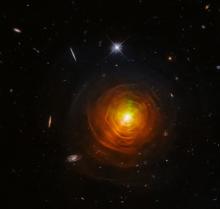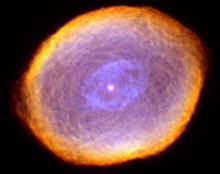Listen to today's episode of StarDate on the web the same day it airs in high-quality streaming audio without any extra ads or announcements. Choose a $8 one-month pass, or listen every day for a year for just $30.
You are here
Moon and El Nath
The two brightest stars of Taurus, the bull, flank the Moon late tonight. The brighter of the two, Aldebaran, is off to the right of the Moon as they climb into good view, about 1 a.m. The second-brightest star, El Nath, is closer to the left or lower left of the Moon. And it’ll stand even closer to the Moon at first light.
Aldebaran and El Nath are in the same stage of life — they’re giants. Through nuclear fusion, each has burned through the original hydrogen fuel in its core, converting it to helium. Now, it’s burning the hydrogen in a thin shell around the core. At the same time, the core is getting smaller and hotter. Eventually, it’ll get so hot that fusion reactions will fire up in the helium, making the star even bigger and brighter.
Nuclear fusion combines lighter elements to make heavier ones. The process releases energy — a lot of it. The core of the Sun, for example, “fuses” 700 million tons of hydrogen every second, producing 695 million tons of helium. The other five million tons are converted to energy — and that’s what makes the Sun shine.
Even at that rate of consumption, the Sun has so much hydrogen in its core that it won’t run out any time soon. It’s been burning through the hydrogen for four and a half billion years, and it’ll keep doing so for at least five billion years longer — powered by its own giant nuclear reactor.
Tomorrow: naming the planets in other star systems.
Script by Damond Benningfield





